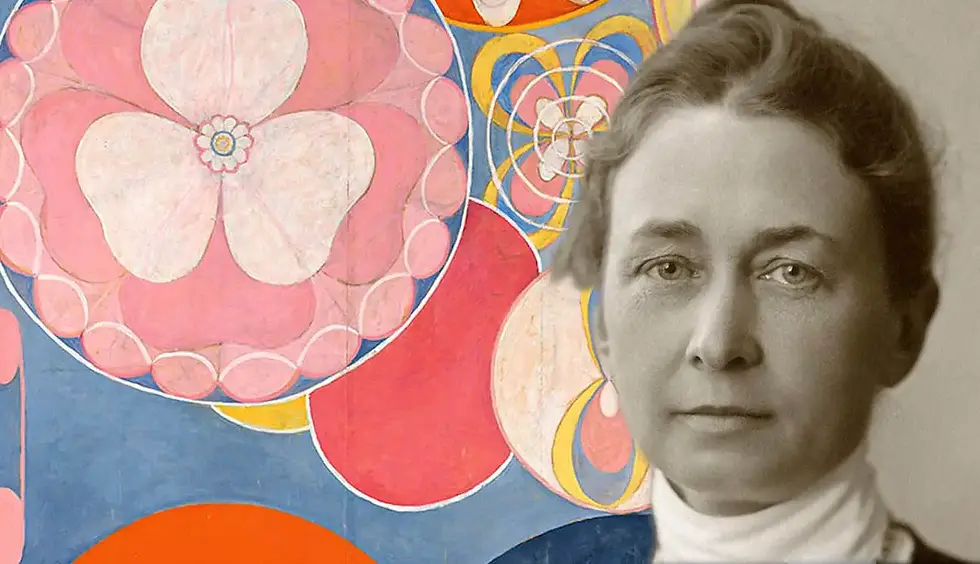Resculpting Art History: The Rediscovered Brilliance of Hilma Af Klint
- Student Gaze

- Aug 20, 2023
- 3 min read
Written By: Vera Chang
Introduction

Oftentimes, debate sparks within the art community regarding who the world’s first abstract artist is. Some argue that it is Wassily Kandinsky, an abstract painter commonly regarded as the pioneer of the European abstract art movement. However, it was not until 1986, when an exhibition in Los Angeles, The Spiritual in Art, rediscovered one of Hilma Af Klint’s works, raising conversations about the authenticity of Kandinsky’s legacy.
Biography
Hilma Af Klint (1862-1944) was born in Stockholm, Sweden and is only getting her notoriety as an abstract painter today. From a young age, Af Klint’s passion in art enabled her to attend classes in portrait painting at a technical school, and later on in 1887, the Royal Academy of Fine Arts,graduating with honours. Soon enough, she was established as a well respected painter in Stockholm, painting naturalistic paintings of landscapes and portraits in a studio. However, between the 1890s and the 1900s, Af Klint became involved in spiritualism and Theosophy and this triggered the shift in her artistic styles.
Work in Spiritualism and Theosophy

Af Klint’s interest in spiritualism was initially reported in 1880 when her sister passed away. But it wasn’t until the 1890s when she dug deeper into the spiritual world. She began to regularly attend spiritual meetings with a group of friends, she called “The Fives”. During their meetings, they would supposedly make contact with the “High Masters” and would document their experiences in notebooks. Her spiritual work also had a practice that followed the process of drawing without consciously guiding the movements of their hands. These all enabled the start to her artistic expression in spiritualism and Theosophy, which is the belief that there is a deeper spiritual reality.

Hilma Af Klint art allowed her to communicate with the spiritual world and present a reflection of another reality. In a sense, she used spirits as a medium in her work, portraying these foreign concepts in physical forms. The communication could be seen through the symbols in her work, with geometric shapes and spirals. Af Klint would create her works with the composition of non-figurative objects and use the motif of the spiral to present her spiritual ideas.
Steiner and Kandinsky’s Legacy

Continuing to pursue her art in spiritualism and Theosophy, she met fellow artist, Rudolf Steiner. Steiner was also a Theosophist and an artist that Af Klint admired. As a result, Af Klint wrote a letter to Steiner inviting him to see her paintings. Contrary to her expectations, he expressed criticism and disappointment in her works, but despite his commentary, Steiner still kept a collection of her work on display in his office. With this noted, it was said that, on some accounts, Wassily Kandinsky, the claimed first abstract artist, had visited Steiner’s office many times and had access to Af Klint’s works. It was often rumoured Kandinsky may have taken inspiration from Af Klint’s works and art movement, rebranding it as his. Furthermore, Af Klint’s first abstract work was painted in 1906, which would pre-date Kandinsky’s first piece by five years. By all this information, it would prove the legitimacy of Af Klint’s title as the first abstract painter, but would also jeopardise Kandinsky’s long legacy in art history.
Conclusion
Even though Hilma Af Klint has been around since the 1860s, her work has been hidden for a long time, and only getting recognition 40 years after her death. Her unique abstraction technique has influenced other renowned artists, yet she has not been rightfully credited. By shining light on Af Klint, it is hoped that more and more will start recognising her talents and take in more consideration of all the other artists hidden in history. It is also important for people to start noticing the problem of female artists, such as Af Klint, who have influenced various art movements, not being credited.





Comments